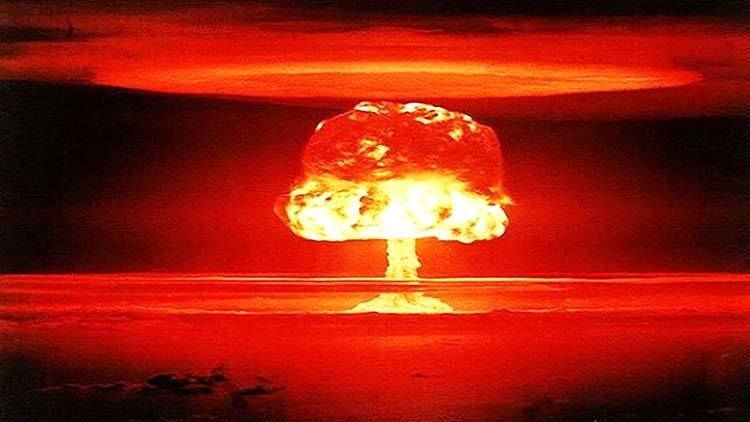
Will Obama Make Good on His Promise to Reduce the Threat of Nuclear Warfare?

As President Obama prepares for his final State of the Union address tonight, there’s one critical issue he has neglected over the last few years that bears revisiting: the nuclear threat, which—along with climate change—poses the biggest risk to the future of the planet.
Fortunately, there are a number of things the president can still do to strengthen international security that would not require him to go through Congress or negotiate with Russia. And taking such executive action would not be out of the ordinary. Indeed, Obama’s Republican predecessors, George H.W. Bush and George W. Bush, both made significant unilateral cuts in the U.S. nuclear arsenal.
According to Stephen Young, a senior analyst at the Union of Concerned Scientists (UCS), Obama could begin tonight by making four related announcements about U.S. nuclear policy. First, he could declare that the U.S. will take its land-based nuclear missiles off hair-trigger alert, abandoning a dangerous, outdated Cold War policy that increases the possibility of an accidental nuclear launch. Second, he could cancel a proposed new nuclear-armed cruise missile that would likely lower the threshold for using nuclear weapons. Third, he could cut U.S. deployed strategic nuclear warheads by a third. And fourth, he could declare that the sole purpose of U.S. nuclear weapons is to deter a nuclear attack on the U.S. and its allies, which would fulfill his promise to reduce the role such weapons play in U.S. policy.
None of these steps would compromise U.S. security. On the contrary, they would not only save U.S. taxpayers hundreds of billions of dollars, they would also make the U.S.—and the rest of the world—a much safer place.
Obama’s Promising Start
President Obama actually addressed the nuclear issue right out of the starting gate. Just a few months after taking office, he gave a widely acclaimed speech in Prague on reducing the threat posed by nuclear weapons. “The existence of thousands of nuclear weapons is the most dangerous legacy of the Cold War,” he said. “And as the only nuclear power to have used a nuclear weapon, the U.S. has a moral responsibility to act. We cannot succeed in this endeavor alone, but we can lead it, we can start it.” He then cited some of the “concrete steps” the U.S. would take “toward a world without nuclear weapons.”
A year later, in April 2010, he was back in Prague to follow through with one of his promised concrete steps: to sign the New Strategic Arms Reduction Treaty (New START) with Russia, further cutting both countries arsenals and reinstituting a strict verification system that the Bush Administration had allowed to lapse. But since then, Obama has not been able to accomplish much else, despite his high hopes. In fact, it seems that his administration is going in the wrong direction. As I reported last August, it wants the U.S. government to spend $1 trillion over the next three decades on a new generation of nuclear warheads, bombers, submarines and intercontinental ballistic missiles (ICBMs).
So, let’s examine Obama’s options to reduce the nuclear threat a bit more carefully.
Take U.S. Land-Based ICBMs Off Hair-Trigger Alert
Since the early days of the Cold War, the U.S. has been keeping its land-based ICBMs in a state of readiness that allows them to be launched within minutes, at least in part to avoid having them destroyed by a surprise nuclear attack. At this point, however, it is highly unlikely Russia would launch a massive first strike and no other country is capable of doing so. What’s more likely is an accidental, erroneous or unauthorized ICBM launch in response to a false attack warning, triggered either by a technical glitch or a human error. In fact, there have been a number of incidents of both kinds in Russia and the U.S. over the last few decades that could have prompted a nuclear launch.
Obama acknowledged the risks posed by this outmoded policy even before he moved into the White House. “Keeping nuclear weapons ready to launch on a moment’s notice is a dangerous relic of the Cold War,” Obama said in an interview published by Arms Control Today in September 2008. “Such policies increase the risk of catastrophic accidents or miscalculation. I believe that we must address this dangerous situation.”
Obama is not alone in that assessment. A number of former secretaries of state and retired high-ranking military officers, including former commanders of the U.S. Strategic Command and the Navy’s nuclear submarine fleet, agree.
Cancel the Long-Range Standoff Missile
The Obama Administration has proposed developing a new, stealthy nuclear-armed cruise missile, dubbed the long-range standoff (LRSO) missile, to replace the air-launched cruise missile (ALCM), which is due for retirement in 2030. The Air Force plans to buy 1,000 to 1,100 of these new missiles—roughly double the 572 ALCMs now in its stockpile—with a price tag of $20 billion to $30 billion.
The new missile would be faster, more accurate and longer-range than the current model. And that’s not good, says Young, the UCS analyst. Why? Because, he says, it will make it easier for the U.S. to use nuclear weapons.
By being more “usable,” the proposed LRSO missile would increase the role that nuclear weapons play in U.S. security policy by lowering the threshold for when the U.S. might consider using one. And that would signal to the rest of the world that the U.S. believes nuclear weapons retain significant war-fighting value. That’s not a message the U.S. should be sending.
“The bottom line,” Young says, “is the proposed missile would not enhance our security. In fact, it would do the exact opposite.”

 233k
233k  41k
41k  Subscribe
Subscribe 
